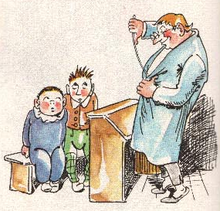Cane
A cane or Bakel ( Latin : baculum = stick, stick) is a walking stick or baton made from a pseudo-woody plant that is lighter and much more elastic than a stick made from normal wood. The material can be, for example, reed , bamboo or rattan .

materials

Reed is very light and fragile. Bamboo cane is very resistant to bending and weathering and is often used in gardening as a growth aid for tying plants, but it also splinters easily. Canes made of rattan, the Germans cane or Spanish cane called, are - despite their name - not hollow, but from a spongy wood and have reached no other wood flexibility on.
history
Thick rattan is suitable for building furniture and as a walking stick . Thin rattan sticks (between 4 mm and 12 mm in diameter), on the other hand, are very flexible and are used as punishing instruments. The cane made of rattan - especially from Malay Malacca - is known for the fact that blows with it (especially cumulative) are very painful and leave characteristic red double welts that leave "twins". To this day, cane blows are administered as judicial punishments in some countries, usually a dozen or a multiple thereof. For this was in the past the whipping bench used, but also in the context of Bastonade came and the cane is often used.
When rattan canes were imported into Europe in the 19th century , they quickly gained popularity, not least because of this property. In European schools, they very quickly replaced the birch rods that had been used up until then as instruments of punishment. In schools and boarding schools, punishment was carried out with a cane on outstretched hands or, especially in boys, on the buttocks, usually in a stooped position or lying over a desk. The number of blows was usually between two and four (when applied to the hands) or three and twelve on the taut trousers. The “six of the best” is known in the English-speaking world as the very painful punishment of the buttocks with six cane lashes, which is only practiced on boys in schools or boarding schools. Its use in the classroom was widespread until the second half of the 20th century. In Germany, the cane was used in families for punishment on the buttocks until well into the 1980s; outside of Germany, it is still in use, especially in the UK (in the family) and in various Asian countries (in school). The cane is also used as a punishment instrument in the BDSM area. However, it is often pointed out here that only very experienced users should perform this type of punishment because of the severe pain and risk of injury.
Other names
In the German-speaking area (mainly Germany, Austria , Liechtenstein and Switzerland ) there were and still are various slang terms for the cane, such as “Gelber Onkel”, “Flitschi” or “Stabl”. Euphemistic names are "Erziehungshelfer", "Popotröster" and "Bravmacher".
See also
literature
- Ingrid Müller-Münch: The battered generation: wooden spoons, canes and the consequences. 3rd edition, Klett-Cotta, Stuttgart 2012, ISBN 978-3-608-94680-2 .
